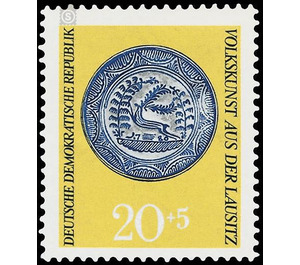Folk art from Lusatia - Germany / German Democratic Republic 1969 - 20 Pfennig
Theme: Art & Culture
| Country | Germany / German Democratic Republic |
| Issue Date | 1969 |
| Face Value | 20.00 |
| Color | blue |
| Perforation | K 13 1/2: 13 |
| Printing Type | offset |
| Stamp Type | Postage stamp |
| Item Type | Stamp |
| Chronological Issue Number | 1264 |
| Chronological Chapter | GER-DDR |
| SID | 36495 |
| In 12 Wishlists | |
Lusatian folk art The Ministry of Posts and Telecommunications of the German Democratic Republic publishes three multi-colored special postage stamps depicting folk art motifs from Lusatia. The amount raised will be made available to the Central Committee of People's Solidarity. Lusatian folk art The area between the Elbe and the Oder on the upper Spree and Neisse, in the eastern part of the German Democratic Republic, is known under the historical name of Lusatia. Old customs are still cultivated in this area and artisan objects are produced by the people. A small selection of them shows the motifs of this special postage stamp series. The 20 + 5 Pfennig value: In the first half of the 18th century, a series of flat containers are likely to be expected, which show on a white tin glaze bold decorations. They were placed on the glaze with "Malhörnchen" (a hollowed cow horn in which a feather pose was inserted) in which clay sludge was mixed with cobalt, similar to today's cake decoration. These decorations show u. a. Hearts, flower baskets, stylized trees, moving animals and coats of arms. On the edge run tendrils and sayings around or rocailles and lambrequins and fill with their decorativeness usually the entire cavity. The dishes may have been found mainly in love and wedding custom or as a representative room decoration, such as in inns, use. However, there were also everyday crockery of this kind. Time, this pottery is based on the years of the previously known pieces approximately 1780-1830. It is partly assumed that the goods originated in the Zittau workshops; on the other hand, Königsbrück manufactured about 1810 "fine white pottery or faience", to which the clay of Meissen was sourced. The faience factories founded in Meissen, Dresden and Torgau during the eighteenth century presumably exerted a style influence on the potteries of Upper Lusatia that should not be underestimated, so that these plates and bowls, decorated with cobalt blue decor, are probably the result of such touches.


